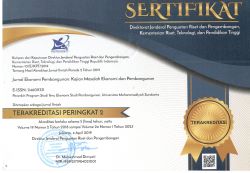Regional Innovation System in Rural Economic Institutional: Empirical Evidence From Semarang, Indonesia
Edy Dwi Kurniati(1*), Indah Susilowati(2), S. Suharno(3)(1) Faculty of Economics and Business,Universitas Darul Ulum Islamic Centre Sudirman GUPPI
(2) Faculty of Economics and Business, Univeristas Diponegoro Semarang
(3) Faculty of Economics and Business, Universitas Jenderal Soedirman Purwokerto, Indonesia
(*) Corresponding Author
Abstract
This study aims to analyze the factors that influence the innovation capacity of the rural economic institution and its impact on institutional performance.Research was conducted by interviewing 111 managers of rural economic institutions in Semarang regency, Indonesia. Factors of policy and regulation, development of innovation infrastructure, assistance and integration of knowledge were used to analyze the role of the Government and Higher Education in the village innovation system. The institutional management and innovation culture capacity factors were used to analyze the role of rural economic institutions. Policy and regulatory factors, innovation infrastructure, management capacity, assistance capacity, innovation culture and knowledge integration were measured based on the preference of the rural economic institution manager. The qualitative model was examined through an empirical analysis to fulfill the proposed aim of the research.The results of the study showed that: the influential factors on the innovation capacity in rural areas were policy and regulation support, innovation infrastructure, management capacity, innovation culture and knowledge management. Innovation Capacity had a positive impact on institutional performance.The implication of this study highlighted the importance of strengthening institutional and knowledge-based rural economic organizations which was integrated among stakeholders as actors in the rural innovation system.
Keywords
Full Text:
PDFReferences
Aldakhil, A. Vonderembse. M. A. (2015) Relationship Between Quality Management Practices and Knowledge Integration and Its Impact On New Product development Performance. https://www.researchgate.net/publication/237727726
Asfaw, S., Mithöfer, D. and Waibel, H., 2010. What impact are EU supermarket standards havingon developing countries’ export of high-value horticultural products? Evidence From Kenya.Journal of International Food and Agribusiness Marketing 22: 252-276.
Bappeda Kabupaten Semarang, 2016. Paparan Workshop SIDA Kabupaten Semarang.
Bardhan, P. 1989. The New Institutional Economics and Development Theory: A Brief Critical Assessment. World Development, 17(9), 1389-1395
Barrett, C.B., (2008). Smallholder market participation: concepts and evidence from eastern and southern Africa. Food Policy, 33, 299-317.
Basagliaa, S., Caporarello, L., Magni, M., Pennarola, F., (2010) knowledge integration capability and team performance. International Journal of Information Management 30 (2010), 542–551
Berdegué, J.A., Balsevich, F., Flores, L. and Reardon, T., 2005. Central American supermarkets’private standards of quality and safety in procurement of fresh fruits and vegetables. Food Policy 30: 254-269.
BPPT, 2013. Naskah Akademik Buku Putih Penguatan Sistem Inovasi Nasional. Jakarta: Deputi Bidang Pengkajian Kebijakan Teknologi Badan Pengkajian dan Penerapan Teknologi.
BPS, 2016. Kabupaten Semarang dalam Angka 2015. Badan Pusat Statistik.
Brillyanes dan Wilopo, 2017. Regional Innovation System In Rural Areas And The Role Of Smes As Countermeasure For Poverty: A Case In East Java, Indonesia. RJOAS, 6(66), 215-223
Coase, R. H. (1937). The nature of the firm. Economica, 4(16), 386-405.
Dorward, A., Poole, N., Morrison, J., Kydd, J. & Urey, I., (2003). Markets, institutions and technology: missing links in livelihoods analysis. Development Policy Review, 21, 319-332.
Grant, R. M. (1996a). Prospering in dynamically competitive environments: Organizational capability as knowledge integration. Organization Science, 7(4), 375–387.
Grant, R. M. (1996b). Towards a knowledge-based theory of the firm. Strategic Management Journal, 17, 109–122.
Hassan, M., Mukhtar, A., Qureshi, S.U., Sharif, S. (2012). Impact of QMP Practices on Firm’s Performance ofPakistan’s Manufacturing Organizations. International Journal of Academic Research in Business and Social Sciences, 2(10), 232-259
Indonesian Central Bureau of Statistics. (2016). Semarang Regency in Figure.https://www.bps.go.id/
Muriithi, B.W., Mburu, J. and Ngigi, M., 2011. Constraints and determinants of compliance withEurepGap standards: a case of smallholder french bean exporters in Kirinyaga district, Kenya.Agribusiness 27: 193-204.
North, Douglass C. (1991), Institutions, Journal of Economic Perspectives, 97-112.
OECD. 2005. Oslo Manual, 3rd Edition. (2005). Guidelines for collecting and interpreting innovation data. OECD, Eurostat, Paris.
Pyburn, R. and J. Woodhill (eds.) 2014.Dynamics of Rural Innovation – A primer for emerging professionals.LM Publishers, Arnhem
Raynolds, L.T., 2004. The globalization of organic agro-food networks. World Development32: 725-743.
Royer, A., Bijman, J. and Bitzer, V. (2016). Linking smallholder farmers to high quality food chains: appraising institutional arrangements. Quality and innovation in food chains. Wageningen Academic Publishers, 1-274.
Saad, M. and Zawdie, G. (2005) ‘From technology transfer to the emergence of a Triple Helixculture: the experience of Algeria in innovation and technological capability development’,Technology Analysis & Strategic Management, 17(1), 89–103.
Schumpeter, J.A. (1934). The Theory of Economic Development. Cambridge, MA:
Smith, A.,(1776). An Inquiry into the Nature and Causes of the Wealth ofNations. Edited by S.M. Soares. MetaLibri Digital Library, 1-743.
Sumpeno et al., 2017. Modul Pelatihan Percepatan Program Inovasi Desa Tenaga Ahli P3MD. Kementerian Desa, Pembangunan Daerah Tertinggal, Dan Transmigrasi Republik Indonesia
Uhl-Bien, M., Marion, R., & McKelvey, B. (2007). Complexity leadership theory: Shifting leadership from the industrial age to the knowledgeera. The leadership quarterly, 18(4), 298-318.
Verheul, I. dan A.R. Thurik, 2001. Start-up capital: differences between male and female entrepreneurs. Does jenis kelamin matter?. Small Business Economics, forthcoming.
Wallace, P. 2006. The new world of work and organizations: Implications for human resource management. Human Resource Management Review 16 83–85
Williamson, Oliver E. 2000, The New Institutional Economics:Taking Stock, Looking Ahead,Journal of Institutional and Theoretical Economics, 99-118.
Article Metrics
Abstract view(s): 1299 time(s)PDF: 887 time(s)
Refbacks
- There are currently no refbacks.
















